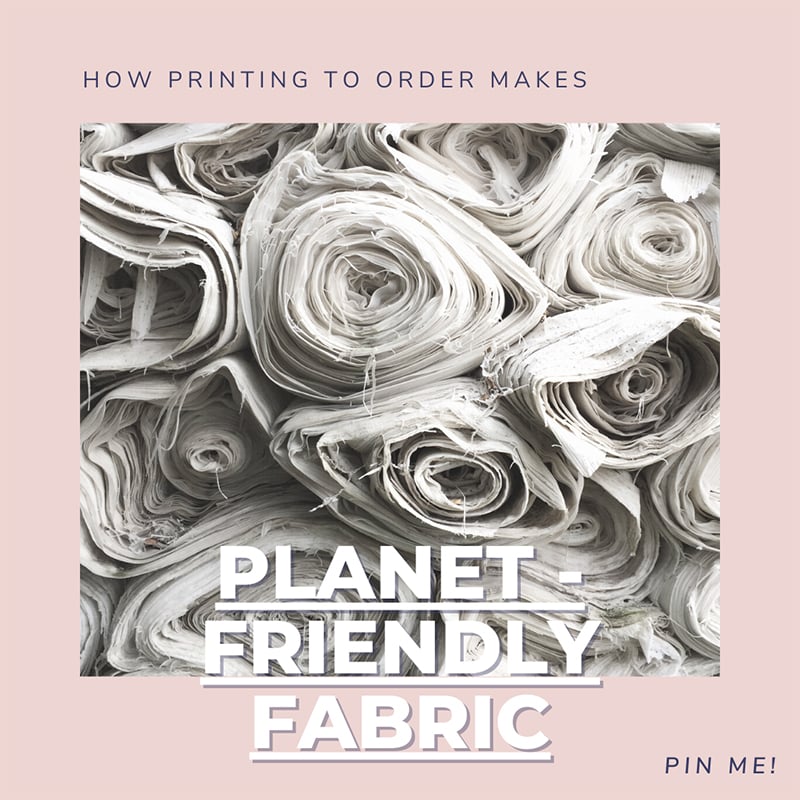How printing to order helps create planet-friendly fabric
 Whenever you choose to order custom fabric through Digital Fabrics instead of a retail store, you reduce fabric waste in the world. The reality is that every year, Australians discard an average of 23kgs of textiles per person. In total, approximately 800,000 tonnes of textiles are sent to Australian landfills each year (and more has been historically sent overseas). This makes Aussies the second highest consumers of textiles behind the United States.
Whenever you choose to order custom fabric through Digital Fabrics instead of a retail store, you reduce fabric waste in the world. The reality is that every year, Australians discard an average of 23kgs of textiles per person. In total, approximately 800,000 tonnes of textiles are sent to Australian landfills each year (and more has been historically sent overseas). This makes Aussies the second highest consumers of textiles behind the United States.
As we are emerging into the new world of social media and the ease of shopping accessibility, micro trends (which typically last 3-5 years) are now playing out in a matter of months.
The rise of fast fashion
Fashion is now the second most polluting industry on the planet – usurped only by oil production. The business of churning out fashion options to hungry consumers who crave the head-spinning speed of trends has a lot to answer for.
When large clothing conglomerates begin a design cycle, they order immense amounts of fabric. If all this fabric is not used, or if the clothing isn’t in demand; it becomes something known as deadstock fabric. Deadstock fabrics remain in the system, generally becoming waste, destined for landfill or incineration; generating greenhouse gases and other toxic emissions.
In 2018, we saw many eyes turn to fashion houses as whistleblowers exposed the burning of perfectly good stock, in order to preserve exclusivity. Fast-fashion giant H&M reportedly destroyed 60 tons of new and unsold merchandise between 2013-2017, a strategy also undertaken by Louis Vuitton, Nike and Burberry.
On top of this issue, according to UN figures, the production of one cotton shirt requires 2700 Litres – the amount a person drinks in 2.5 years! The 2.5 trillion dollar fashion industry is the 2nd highest user of water in the world. These numbers are shocking.
In May 2021 participants from across retail, fashion, charity, production, environment, research and waste management came together for Australia’s first ever National Clothing Textile Waste roundtable, hosted at Parliament House in Canberra.
This roundtable signals the start of a collaborative effort, drawing on a diversity of expertise across Australia to create action to reduce waste from clothing textiles going to landfill. There was a particular focus on increasing the ability to recycle textiles and driving action to improve product stewardship of textile waste. However, this doesn’t address the amount of textiles still being produced at large.
Why Digital Fabrics are doing things better
At Digital Fabrics, we don’t have piles of unsold or unused fabric sitting in the studio destined for landfill once a trend has trickled down to nonexistence. We only ever print-to-order and with low minimum order quantities of as little as 1 metre of fabric or 1 cushion cover this significantly reduces deadstock and wastage.
Sending us your own fabric designs gives you control over what your label, store or DIY project looks like, aligning directly with your style and project requirements. You can also shop directly from our range of designer textile prints which can be custom printed on any of our stocked fabrics.
Order what you need
Everything is printed for you on-site in Marrickville, Sydney and is strictly print ‘on demand’! This means we only use the materials that are completely necessary for each order placed, with minimal waste. We put a lot of effort and time sourcing our fabrics from reliable suppliers who either manufacture their fabrics preferably locally or have long-standing, established relationships with their manufacturers, ensuring the production and supply of high-quality fabrics. Most of our fabrics are from overseas manufacturers and are OEKO certified, which means that the manufacturer meets certain health, safety, environmental, and quality targets.
Whilst we take measures to keep waste to an absolute minimum there is still some waste during any production process. Any left-over unprinted fabric is either re-used by us for samples and strike-off printing, recycled or donated to local makers or craft groups who always have creative ways of repurposing the fabric.
We believe in slow fashion, and believe that we can all do our part to reject fast-fashion practices in favour of more sustainable methods, ethical workplaces, and supporting local makers.
Like the sounds of sustainability? Shop our fabrics now.
To gain some knowledge, research, and write this blog post we’ve used information that we’ve found in the reference links below. We know that you are curious just like us so please feel free to browse these links and learn more about textile waste in the world and its impact.
https://www.planetark.org/newsroom/news/tackling-australias-textile-waste
https://www.instagram.com/p/CgpkKDyPEez/?hl=en
https://www.dcceew.gov.au/environment/protection/waste/product-stewardship/textile-waste-roundtable
https://www.vox.com/the-goods/2018/9/17/17852294/fashion-brands-burning-merchandise-burberry-nike-h-and-m
https://unece.org/fileadmin/DAM/RCM_Website/RFSD_2018_Side_event_sustainable_fashion.pdf
https://www.dcceew.gov.au/environment/protection/waste/product-stewardship/textile-waste-roundtable